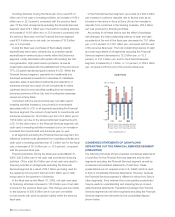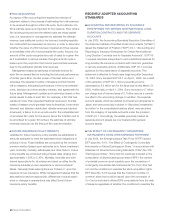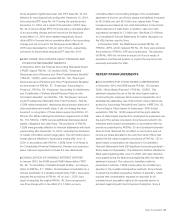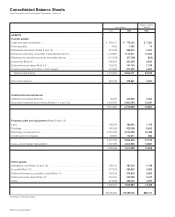Sony 2005 Annual Report Download - page 69
Download and view the complete annual report
Please find page 69 of the 2005 Sony annual report below. You can navigate through the pages in the report by either clicking on the pages listed below, or by using the keyword search tool below to find specific information within the annual report.66 Sony Corporation
■FILM ACCOUNTING
An aspect of film accounting that requires the exercise of
judgment relates to the process of estimating the total revenues
to be received throughout a film’s life cycle. Such estimate of a
film’s ultimate revenue is important for two reasons. First, while a
film is being produced and the related costs are being capital-
ized, it is necessary for management to estimate the ultimate
revenue, less additional costs to be incurred, including exploita-
tion costs which are expensed as incurred, in order to determine
whether the value of a film has been impaired and thus requires
an immediate write off of unrecoverable film costs. Second, the
amount of film costs recognized as cost of sales for a given film
as it is exhibited in various markets throughout its life cycle is
based upon the proportion that current period actual revenues
bear to the estimated ultimate total revenues.
Management bases its estimates of ultimate revenue for
each film on several factors including the historical performance
of similar genre films, the star power of the lead actors and
actresses, the expected number of theaters at which the film
will be released, anticipated performance in the home entertain-
ment, television and other ancillary markets, and agreements for
future sales. Management updates such estimates based on the
actual results to date of each film. For example, a film that has
resulted in lower than expected theatrical revenues in its initial
weeks of release would generally have its theatrical, home enter-
tainment and television distribution ultimate revenues adjusted
downward; a failure to do so would result in the understatement
of amortized film costs for the period. Since the total film cost to
be amortized for a given film is fixed, the estimate of ultimate
revenues impacts only the timing of film cost amortization.
■FUTURE INSURANCE POLICY BENEFITS
Liabilities for future insurance policy benefits are established in
amounts adequate to meet the estimated future obligations of
policies in force. These liabilities are computed by the net level
premium method based upon estimates as to future investment
yield, morbidity, mortality, withdrawals and other factors. Future
policy benefits are computed using interest rates ranging from
approximately 1.30% to 5.20%. Mortality, morbidity and with-
drawal assumptions for all policies are based on either the life
insurance subsidiary’s own experience or various actuarial
tables. Generally these assumptions are “locked-in” upon the
issuance of new insurance. While management believes that the
assumptions used are appropriate, differences in actual experi-
ence or changes in assumptions may affect Sony’s future
insurance policy benefits.
RECENTLY ADOPTED ACCOUNTING
STANDARDS
■ACCOUNTING AND REPORTING BY INSURANCE
ENTERPRISES FOR CERTAIN NONTRADITIONAL LONG-
DURATION CONTRACTS AND FOR SEPARATE
ACCOUNTS
In July 2003, the Accounting Standards Executive Committee of
the American Institute of Certified Public Accountants (“AcSEC”)
issued the Statement of Position (“SOP”) 03-1, “Accounting and
Reporting by Insurance Enterprises for Certain Nontraditional
Long-Duration Contracts and for Separate Accounts”. SOP 03-
1 requires insurance enterprises to record additional reserves for
long-duration life insurance contracts with minimum guarantee
or annuity receivable options. Additionally, SOP 03-1 provides
guidance for the presentation of separate accounts. This
statement is effective for fiscal years beginning after December
15, 2003. Sony adopted SOP 03-1 on April 1, 2004. As a result
of the adoption of SOP 03-1, Sony’s operating income
decreased by 5.2 billion yen for the fiscal year ended March 31,
2005. Additionally, on April 1, 2004, Sony recorded a 4.7 billion
yen charge (net of income taxes of 2.7 billion yen) as a cumula-
tive effect of an accounting change. In addition, the separate
account assets, which are defined by insurance business law in
Japan and were previously included in “Securities investments
and other” in the consolidated balance sheet, were excluded
from the category of separate accounts under the provision
of SOP 03-1. Accordingly, the assets previously treated as
separate account assets are now treated within general
account assets.
■THE EFFECT OF CONTINGENTLY CONVERTIBLE
INSTRUMENTS ON DILUTED EARNINGS PER SHARE
In July 2004, the Emerging Issues Task Force (“EITF”) issued
EITF Issue No. 04-8, “The Effect of Contingently Convertible
Instruments on Diluted Earnings per Share.” In accordance with
Statement of Financial Accounting Standards (“FAS’’) No.128,
“Earnings per Share’’, Sony had not previously included in the
computation of diluted earnings per share (“EPS’’) the number
of potential common stock issuable upon the conversion of
contingently convertible debt instruments (“Co-Cos’’) that had
not met the conditions to exercise the stock acquisition rights.
EITF Issue No. 04-8 requires that the maximum number of
common stock that could be issued upon the conversion of
Co-Cos be included in diluted EPS computations from the date
of issuance regardless of whether the conditions to exercise the
BH6/30 Adobe PageMaker 6.0J /PPC
























